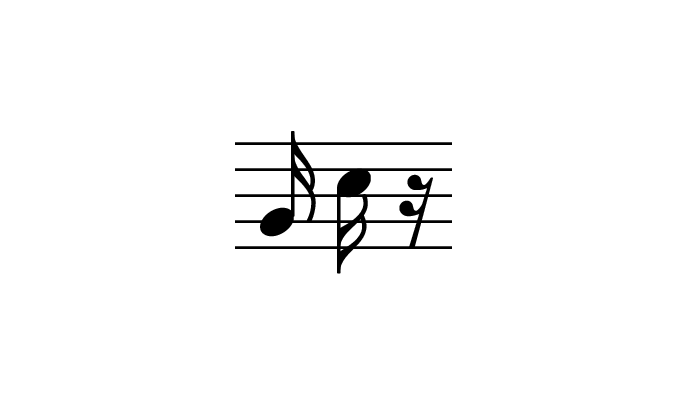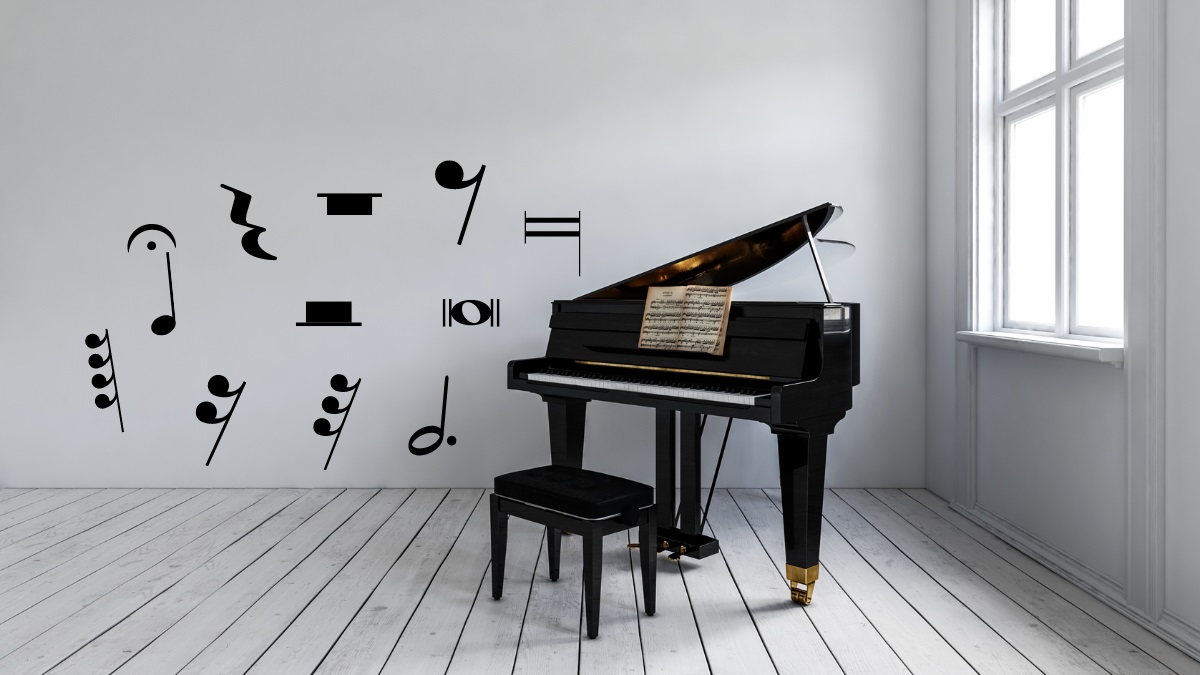Music is known for being the universal language of humanity! It doesn’t matter where you’re from or what ethnic background or language you speak if you want to enjoy music.
Musical notations helped in bringing the world together by making music universally connected through symbols and notes. Among these symbols are the rests.
A typical rest in music is usually a symbol in the musical notes that the musician should respond to by not playing, and therefore, results in silence.
Note values and rests will correspond to various symbols and each one of them represents a different length of the pause.
Ideally, there are 11 types of rest in music, and some of them are more commonly used than others.
In today’s article, we’ll walk you through each one of these rests, so you can have a better understanding of them.
1. Double Whole Note Rest

A double whole note rest is also known as a “double rest” or “breve rest” in British. It’s considered the second long rest value that is still in use in modern sheet music.
As the name suggests, this note indicates silence for double the duration of a whole note, which means that the player should pause for 8 beats in a 4/4 time signature.
They’re usually drawn as an opaque or filled-in vertical rectangle that occupies the whole space between 2nd and 3rd lines from the top of the musical staff. Breve rests are usually used to indicate long silent pauses that aren’t split into separate bars.
2. Whole Note Rest
A whole note rest is also known as “whole rest” or “semibreve rest” in British. This one has the same time duration as the whole note in a 4/4 time signature. So, if you see a whole note rest, you should pause for 4 beats.
A semibreve rest will usually apply for an entire measure. However, it might occasionally indicate a rest for the whole note’s duration in longer time signatures, such as in 3/2 or 5/4.
In most cases, they’re usually drawn as an opaque or filled-in horizontal rectangle that starts from under the second line from the top of the musical staff.
But, they can be drawn in a ledger line or other different lines in some polyphonic passages, especially when two instruments are denoted on the same staff and only one of them will be silenced.
3. Half Note Rest

The half note rest, also known as “half rest” in American and “minim rest” in British. They’re related to half notes in which they cover half of the duration of a whole note.
A half rest means that you have to pause for 2 beats in a 4/4 time signature or half the length of a whole rest.
A half note rest is drawn as a filled-in or opaque rectangle, exactly as the whole rest and the double whole rest.
The only difference here is that this one is drawn so that it’s sitting on the third line from the top of the 5-line musical staff (the middle line).
4. Quarter Note Rest
The quarter note rest, also known as the “quarter rest” or “crochet rest” in British. This rest is one of the most unique when it comes to drawing.
However, its rest duration is quite easy to grasp. This one covers a duration of silence that is equivalent to a quarter a note, which in most cases is a single beat, depending on the time signature of the music.
A quarter note rest looks like a warped or skewed letter “Z” with a small “c” attached to its bottom. Because the symbol is quite difficult to draw, some people might use the older music symbol.
5. Eighth Note Rest
Next up we have the eighth note rest, which is also known as a “quaver rest” in British. This one covers a silence duration equivalent to 1/8 of a full note, which is equivalent to half a beat in a 4/4 time signature.
Drawing this note is quite easy, especially when compared to the quarter note. All you have to do is draw a number “7” in the middle of the 5-line musical staff, then attach a tiny opaque circle over the tip of the 7’s head.
An eighth note (American) or a quaver (British) is a musical note played for one eighth the duration of a whole note (semibreve), hence the name.
6. Sixteenth Note Rest

Based on the previous note rests, it’d be easy to predict a lot of the elements of the sixteenth note rest. It’s called “semiquaver rest” in British and represents a silence period of 1/4 a beat or 1/16 a note in a 4/4 time signature.
Its symbol is extremely similar to the eighth note rest but it has an extra opaque circle with a flick that is hanging out from the center of the “7” structure. Also, it sits on the bottom line of the 5-line musical staff.
7. Thirty-Second Note Rest
The thirty-second note rest, also known as “demi-semiquaver” in British represents the silence period played for about 1/32 of a durable of a whole note or half the duration of a sixteenth note rest.
Drawing the thirty-second note is quite simple. It carries the same base structure as the eighth and the sixteenth note rests. To distinguish the thirty-second note rest, you add a third opaque circle with a flick.
8. Sixty-Fourth Rest
The note rests keep getting smaller until it reaches the sixty-fourth rest. This one is known as “hemidemisemiquaver” or “semidemisemiquaver” in British and drawn with a 4th opaque circle with a flick on the same base structure.
This is the shortest rests that are used in modern musical notation, although values used to go as low as 256th note with a British name that takes the “Hemi-demi-semi” thing to a whole new level of complication!
9. Dotted Rests
This one isn’t a separate rest on its own but rather an indication of a rest. When you see any of the previous rests followed by a dot, it means that the duration of silence should be one and a half the length of its undotted counterpart.
Due to its mathematical complexity, this one is rarely used in modern musical notations except in compound meters, such as 12/8.
10. Longa Rest
The longa rest is one of the largest rests in terms of duration. It’s equivalent to a quadruple of whole note rest.
It’s drawn as a vertical rectangle that connects the second and fourth lines in a 5 line musical staff.
11. Rests with a Pause Symbol

To understand what this rest symbol means, you should first know what a pause is. In sheet music, there is a slight difference between a pause and a rest.
While rests are considered intervals of silence in a piece of music, pauses are symbols that indicate that you hold a beat for longer than it should.
A fermata belongs to another group of musical notation symbols known as “pauses”.
Ideally, there are 3 popular pauses marking that can be associated with rests. These are the fermata, the general or long pause, and the caesura.
Rest with a Fermata
A fermata actually comes from Italian for “stop” and it dates back to as early as the 15th century. As a rule of thumb, a fermata will usually indicate that you need to hold or sustain any note longer than its regular value.
In some cases, a fermata can show up above a rest symbol, such as a whole rest. If you see a rest with a fermata in your musical sheets, it means that the exact length of the pause you’re making is left to your or the performer’s discretion.
This means that you get to choose whether you want to extend the note for a lengthened effect or just play the note exactly as notated in the sheets.
As the name suggests, fermatas usually come right before a double barline at the end of times segments or measures.
Rest with a General Pause (G.P.) or Long Pause (L.P.)
If you find your note accompanied with a symbol of long or general pause, it indicates silence of all musical instruments or voices. Long pauses are also known as Lunga, which is different from the previously mentioned Longa.
It’s usually marked as a G.P. or an L.P. over a whole rest in the sheets. Similar to the fermata, this one leaves the length of the pause to the performer or the conductor’s discretion.
Caesura
A caesura is usually expressed as a couple of forward slashes (//) or upright lines (||) that are parallel to each other, which is why it’s colloquially known as “the railroad tracks”. They can also be symbolized by commas (,) and ticks (✓).
This one is quite similar to long pauses and general pauses. However, the difference between them is that caesuras usually indicate a shorter interval of silence. When the caesura is shown with rests, it usually indicates sudden silence and sudden resume.
Wrap Up
With that said, we conclude today’s article about the types of rest in music! As you can see, rests are quite essential for musical notations.
By implementing and using rests in music, you’ll be able to shift the listener’s attention from one element to the other!
However, they’re quite different from music pauses, which are meant to actually let the musicians rest, in addition to various musical purposes.







